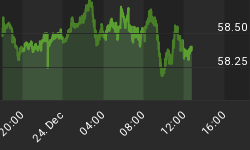We believe the risks for Bondholders leans toward a rise in prices, and substantially declining long-term interest rates. This is frightening, as it means we are about to enter another recession, one that could be deeper than we have seen in a long time. Why do we see this as an increasing risk? Primarily what has changed is the development of a Symmetrical or hybrid Ascending Bullish triangle from 2002, shown below. Triangles are usually wave fours, so that means we have a wave five up coming after this pattern completes. Whether this pattern is a Symmetrical Triangle or is an Ascending Triangle, both are Bullish for prices. In the case of a Symmetrical, the trend leading into the triangle is the trend that will continue after it completes -- in this case up. In the case of Ascending, they are almost always Bullish.


The first chart shows the long-term Elliott Wave labeling from 1982 when bonds bottomed, ending a century long decline in prices, perhaps of Supercycle degree. Perhaps the labeling is one degree too low, that the Intermediate labels should be primary degree, that the minor degree labels should be intermediate degree. It matters little, for the point is, once this triangle finishes, a major rally in Bonds should unfold, higher than we saw in 2000, which means long-term interest rates could approach 1 or 2 percent, which suggests a major recession or even depression could be coming. I hope I'm wrong.
Timing? It looks to us like wave d up has topped. Bonds are now declining into the final wave e down through the beginning to middle of 2007. Then we should see wave 5 up, and the recession as well. At this time, we also have an inverted yield curve, which often predicts recessions, so it all fits.
How could Bonds rise to these levels, given the possibility of a contemporaneous Dollar devaluation -- perhaps in half? Both scenarios suggest a response to a single problem -- a housing market disaster. With over a trillion dollars of adjustable rate mortgage debt about to reset for the first time in 2007, as teaser rates come home to roost, with little interest to buy real estate at current price levels, it isn't hard to see the looming disaster. If housing prices fall due to supply exceeding demand, Banks and mortgage-backed security holders are at risk. Homeowners are at risk. If you were the Working Group, a.k.a Plunge Protection Team, what would you do? Answer is, devalue the dollar so that the real value of debt is diminished, and buy Bonds so long-term interest rates are low enough to act as an incentive for another round of payment-reducing mortgage debt, which of course would stimulate housing demand and support prices (from the creditor's perspective, collateral values). These charts suggest it all is likely to happen.

For a Free 30 day Trial Subscription, go to www.technicalindicatorindex.com and click on the button at the upper right of the Home Page.
"Jesus answered and said to him, "For God so loved the world that He gave His only begotten Son, that whosoever
believes in Him should not perish, but have eternal life.
For God did not send the Son into the world to judge the world,
but that the world shall be saved through Him.
He who believes in Him is not judged;
He who does not believe, has been judged already, because
he has not believed in the name of the only begotten Son of God."
John 3:16-18
We wish you a healthy and prosperous New Year!
If you are a trader, we offer market timing signals. If you are a conservative long-term investor, we manage our Conservative Balanced Investment Portfolio, and publish our transactions on a regular basis.
















